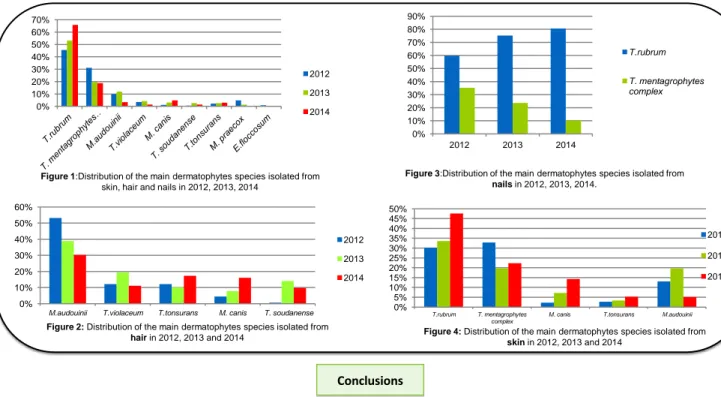Dermatophytosis refers to superficial fungal infections of keratinized tissues caused by keratinophilic dermatophytes. They are the most common cause of superficial fungal infections worldwide. Epidemiological studies regarding dermatophyte infections have been conducted in several countries and differences in the incidence and in etiological agents have been reported for different geographical areas. That is why national surveillance of circulating strains causing dermatophytosis is crucial. The Belgian National Reference Center (NRC) for Mycoses conducted a survey on dermatophytes strains circulating from 2012 to 2014. The present study was performed to assess the profile of dermatophytosis and to identify the species involved.
Objectives
Methods
Among the 9138 samples, 3587 were identified as dermatophytes.
Trichophyton. rubrum (T. rubrum) is the most prevalent species 56,17% (n=2015) from all sources, followed by T. mentagrophytes complex (21,83%,
n=783) (Fig. 1).
Predominance of anthropophilic species causing tinea capitis especially M. audouinii responsible for 36,49% (n=163/448) of hair/scalp infection.
Trichophyton violaceum is also well represented,12,8% (n=57) (Fig.2).
The epidemiological study organized in 2013 by the NRC mycoses can partially explain the huge amount of M.audouinii and T. violaceum isolated during this year.
M. canis and T. tonsurans are increasing in hair samples from 2012 to 2014 (Fig.2).
High prevalence of T. rubrum commonly observed in Europe as causal agent of onychomycosis (70,9%, n=1603) followed by T. mentagrophytes
complex (20,9%, n=455) (Fig. 3).
Constant increase of T. rubrum in nails and on the contrary, constant decrease of T. mentagrophytes complex from 2012 to 2014 (Fig.3).
T. rubrum and T. mentagrophytes complex are responsible for the majority of skin infections as they represent respectively 40% (n=386) and 24,75%
(n=239) of skin dermatophytosis during the study period. M. canis was an increasing etiologic agent in skin samples (Fig.4).
Conclusions
Sacheli Rosalie1, Darfouf Rajae1, Graide Hélène2, Adjetey Caroline2,Pateet Sofie3 , Lagrou Katrien3
, Hayette Marie-Pierre1.
1National Reference Center for Mycosis, 2Department of Clinical Microbiology, University Hospital of Liège Belgium 3 Department of Microbiology and Immunology, University Hospitals Leuven,
Belgium.
Corresponding author
r.sacheli@chu.ulg.ac.be
A 3-year survey of dermatophytosis in Belgium
The present work has provided recent data on the prevalence of several dermatophytes species circulating in Belgium. Such data is critical for the establishment of therapeutic strategies and measures for prevention and control of dermatophytes infections. Our study confirms the predominance of
T. rubrum followed by T. mentagrophytes in the Belgian population but also highlights the emergence of new anthropophilic species such as M. audouinii and T. violaceum as causative agents of tinea capitis in children in relation with African immigration.
Results
0% 10% 20% 30% 40% 50% 60% 70% 2012 2013 2014
Figure 1:Distribution of the main dermatophytes species isolated from
skin, hair and nails in 2012, 2013, 2014
Figure 2: Distribution of the main dermatophytes species isolated from hair in 2012, 2013 and 2014 0% 10% 20% 30% 40% 50% 60% 70% 80% 90% 2012 2013 2014 T.rubrum T. mentagrophytes complex
Figure 3:Distribution of the main dermatophytes species isolated from nails in 2012, 2013, 2014. 0% 5% 10% 15% 20% 25% 30% 35% 40% 45% 50% T.rubrum T. mentagrophytes complex
M. canis T.tonsurans M.audouinii
2012 2013 2014
Figure 4: Distribution of the main dermatophytes species isolated from skin in 2012, 2013 and 2014 0% 10% 20% 30% 40% 50% 60%
M.audouinii T.violaceum T.tonsurans M. canis T. soudanense
2012 2013 2014
Samples collection from January 2012 to December
2014 (Belgian NRC, UZ Leuven+CHU Liège)
9138 strains
Culture from patients clinically suspected for fungal infections
of skin, hair and nails.
Fungal identification was performed by microscopy
after subculture
ITS sequencing in case of doubtful
